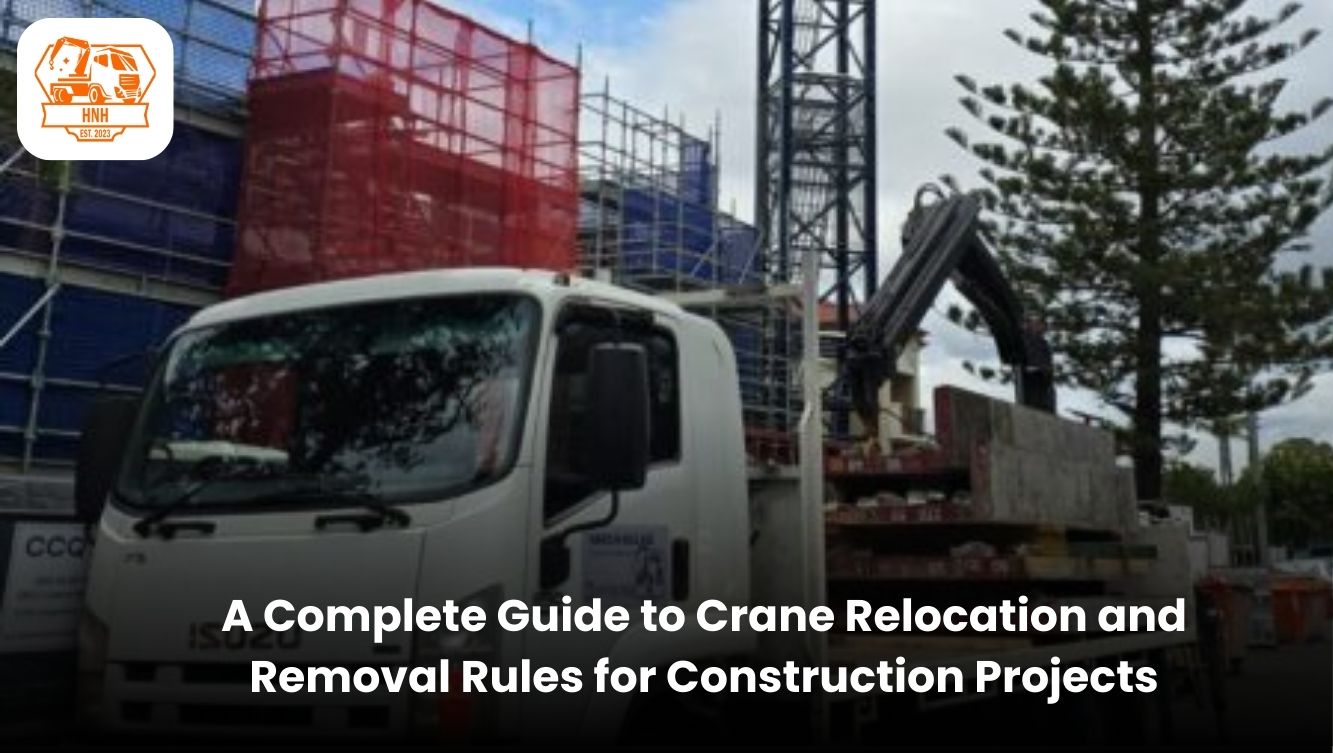A Complete Guide to Crane Relocation and Removal Rules for Construction Projects
Cranes are the backbone of modern construction, handling everything from lifting steel beams to moving large machinery. However, when a project reaches a new phase or is fully wrapped, the crane is often required to be shifted, dismantled, or removed from the site. This process isn’t just about logistics — it involves strict security measures, legal compliance, and expert planning. That’s why understanding relocation and removal rules is so important for contractors and project managers. With the right approach and professional crane hire services, you can ensure the job is completed safely, efficiently, and without costly delays.
What is Crane Relocation and Removal?
Before diving into the rules, let’s clarify what we mean by crane relocation and removal.
- Crane Relocation: This involves dismantling or moving a crane from one Place to another — either in the same location or completely on the new site. Relocation ensures the crane is distributed where it can safely and effectively complete its lifting tasks.
- Crane Removal: This refers to dismantling and removing a crane entirely once its work on a site is complete. This can be different for storage, maintenance, or transport to another project.
When is it required?
- At the end of a construction phase
- When a crane must be repositioned for new tasks
- If the security risk appears at the current location
- When many projects go on Equipment between websites
Why Rules and Regulations Matter
Cranes are large machines, and relocating or removing them without rules could cause terrible accidents. That’s why rules exist. They ensure:
- Worker & Public Safety: Prevents accidents, injuries, or fatalities on-site.
- Equipment Protection: Avoids damage to expensive cranes and construction materials.
- Legal Compliance: If the rules are not followed, construction companies can meet severe penalties.
- Insurance & Liability: If the security protocol is ignored, the insurance companies may refuse claims.
Put simply: following relocation and removal rules keeps people safe, projects on schedule, and businesses legally protected.
Crane Pre-Relocation Checklist
Before moving or removing a crane, contractors should run through a checklist:
- Conduct a full site inspection for hazards
- Review ground conditions and weather forecasts
- Confirm crane capacity matches relocation needs
- Inspect rigging equipment, slings, and hooks
- Ensure only certified operators and riggers are involved
- Secure necessary permits or approvals for road transport
- Communicate the plan with all site workers
This checklist helps identify problems early and reduces risks during the process.
Key Crane Relocation Rules
Transfer of the crane is more than a technical function – this is a regulated process. Here are the necessary rules:
- Site Assessment: Before continuing, survey the new site to confirm basic stability, location and load capacity.
- Dismantling & Reassembly: Follow the manufacturer’s instructions carefully. Incorrect resolution can damage parts or pose a future security risk.
- Certified Operators & Riggers: Only trained professionals should handle dismantling, lifting, and reassembly.
- Load Capacity Checks: Never exceed the crane’s rated lifting limits during relocation.
- Weather & Ground Conditions: Relocation should be avoided during strong winds, heavy rain, or unstable ground conditions.
Following these rules ensures the crane arrives at its new position in perfect working condition.
Key Crane Removal Rules
When a crane has completed work, safe removal is equally important:
- Safe Dismantling Procedure:Break the crane systematically and starts with non-bearing sections.
- Traffic & Transport Regulations: Large crane components often require special permits and police escorts during road transport.
- Rigging Standards: Use high-quality,inspect the rig equipment to lift and load dismantled parts.
- Reuse or Disposal: Decide whether dismantled parts will be reused, refurbished, or scrapped.
- Post-Removal Inspection: Inspection The place for remaining dangers such as bolts, anchor or concrete pads.
By following these rules, removal becomes safe and efficient, avoiding costly delays.
Role of Rigging in Relocation and Removal
Rigging plays an important role in both relocation and removal. Without the right rigging practices, the possibility of accidents heaven touches.
- Lifting Gear Selection: It is necessary to choose the right sling, hook and shackles.
- Load Balancing: Proper rigging ensures that the weight of the crane is equally distributed during lifts.
- Accident Prevention: Safe rigging is avoided from tipping, turning load or dropped equipment.
Professional riggers are the unsung heroes who keep crane relocation and removal projects safe.
Common Challenges in Crane Relocation & Removal
Even with rules in place, contractors face challenges such as:
- Heavy Traffic During Transport: Moving crane parts through busy roads requires permits and escorts.
- Unstable Ground or Weather: Rain, storms, or soft ground can delay relocation.
- Miscommunication: Poor coordination between crane operators, riggers, and contractors leads to mistakes.
- Cost & Downtime: A crane spends useless money every day – so the delay needs to be minimized.
By planning ahead and hiring professionals, these challenges can be significantly reduced .
How Professional Crane Hire Services Help
Hiring professionals isn’t just convenient — it’s the smartest business decision. Here’s the reason:
- Why Not DIY? Crane relocation is complex. Trying it without experts risk accidents, fine and expensive damage.
- Benefits of Certified Services: With reliable crane trucks Gold Coast and crane truck services Brisbane, you get trained operators, high-quality equipment, and complete safety assurance.
- Reliability & Compliance: Professional crane hire companies know local rules and ensure that each relocation and removal project stays compliant with rules.
Choosing reliable providers like HNH Crane means your project is within the budget, and at the top – safe.
FAQ
Q1. What are the safety rules for crane operations?
Crane operations are never something to take lightly. The golden rule is that only qualified and trained operators should be behind the controls. Loads must always stay within the crane’s capacity, and proper rigging should be followed every single time. On top of that, keeping the site organised and ensuring everyone follows safety protocols goes a long way in preventing mishaps.
Q2. What are the different types of crane hire?
When it comes to hiring cranes, the choice depends on the project. Mobile cranes are versatile and suit most general lifting tasks. Tower cranes are ideal for high-rise construction. Truck-mounted cranes give flexibility with transport and lifting in one. For rough or uneven terrain, all-terrain cranes and crawler cranes are commonly used. Each one is designed with specific site conditions in mind.
Q3. What are the benefits of rigging?
Rigging is the backbone of safe lifting. It ensures that heavy loads stay balanced and secure while being moved. With proper rigging, the chances of accidents or damage drop significantly. It also saves time on site because the lifting process becomes smoother and more controlled, especially during relocation or removal jobs.
Q4. How often do cranes need to be inspected?
Every crane should be checked before starting the day’s work to spot any obvious wear or issues. Beyond these daily checks, more detailed inspections are usually scheduled monthly or yearly. The exact timeline depends on how frequently the crane is used, the manufacturer’s recommendations, and workplace safety requirements.
Q5. How do crane truck services in Brisbane help in relocation projects?
Relocating heavy equipment isn’t just about lifting—it’s about moving, setting up, and dismantling safely. This is where crane truck services in Brisbane make a difference. They bring the right trucks, operators, and rigging know-how to handle the whole process. As a result, projects get completed faster, with less hassle, and in full compliance with local rules.
Conclusion
Cranes are important parts of relocation and removal construction, but they are also high risk processes. By following the rules, by using the right checklists and professional cranes that rely on tenancy services, contractors can avoid accidents, reduce shutdowns and protect the investment.
If you’re planning a crane relocation or removal, don’t leave it to chance. Partner with professionals who specialize in crane truck services Brisbane and offer reliable crane trucks Gold Coast.

